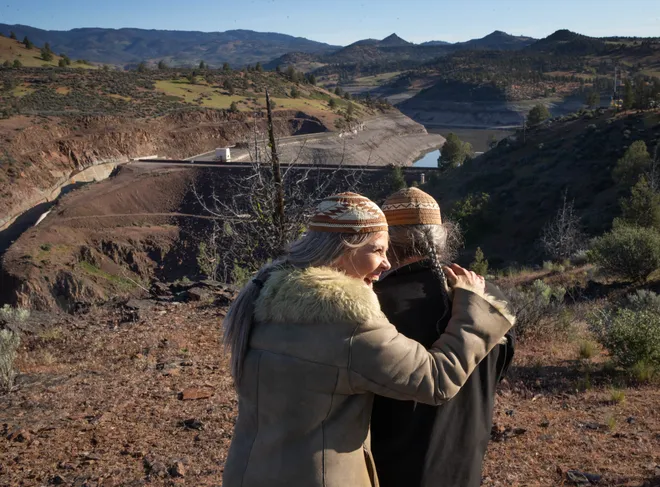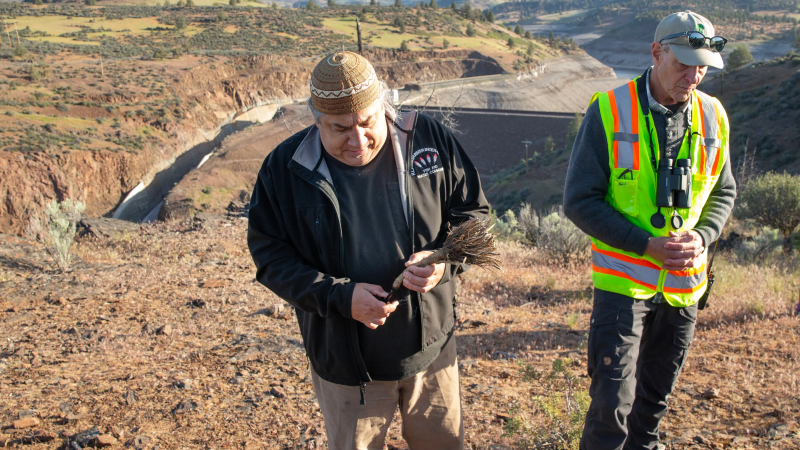As demolition begins on one of the last Klamath River dams, attention turns to recovery
Work has now begun on removing the third of four dams that nearly destroyed salmon populations on the Klamath River in Oregon and California and caused some of the nation's largest-ever fish kills.
Karuk elder Leaf Hillman and his wife, Lisa, were on hand this month to see the first shovelful of dirt scraped from the top of the earthen dam. They and other tribal fish and water protectors had fought for years to demolish the dams that nearly made one of their cultural touchpoints and primary food sources extinct.
"We sweep all the bad things off the downriver edge of the world and off the upriver edge of the world," said Hillman. "We make this place all new again in service of all the spirit people that exist on this earth, both human and nonhuman ancestors and relations."

The Iron Gate Dam was the last of the dams built to provide electricity to Northern California in the early 20th century. The reservoir behind the 173-foot-high dam, which went into service in 1962, was drained in January along with the other reservoirs. Klamath River Renewal Corporation, the nonprofit in charge of the largest dam removal project in the U.S. to date, chose to drain the reservoirs in the dead of winter because it was in between fish runs.
The Arizona Republic, part of the USA TODAY Network, traveled to the Klamath last year for a series of stories about the damage inflicted by the dams and the work to restore wildlife habitat and ancestral homelands.

How removing the dams will change the landscape
Tribes and environmentalists had fought for decades for removal of the dams as part of a basin-wide restoration effort. After a fish kill in 2002, spurred by toxic algae entering the river from the reservoirs that had acted as blue-green algae nurseries, tribes amped up the battle to "undam the Klamath" and restore health to the waters and lands the Yurok, Hoopa, Karuk, Shasta and Klamath Tribes have inhabited and stewarded for millennia.
In 2022, the Federal Energy Regulatory Commission approved the dam removals, and demolition began in 2023. The first dam, Copco II, came down in mid-2023. Copco I demolition began in March. FERC approved an early start to Iron Gate's removal process.
The final dam, JC Boyle, is expected to come down this fall, just in time for Chinook salmon season.
When all the dams are gone and the Klamath flows freely again, salmon and other fish will once again seek out their ancient spawning waters. Water quality, always an issue in northern California and southern Oregon because of high natural concentrations of phosphorus, will improve as free-flowing water carries the nutrient away. Wetland and juvenile fish habitat restoration is also in progress.
Hillman acknowledged that the dams and reservoirs are on the ancestral lands of the Shasta Indian Nation. The 300-member tribe has asked for the return of 2,200 acres of land that were once under water. The land was taken by eminent domain in the early 1900s.
"They have been gracious in allowing us to do this work," he said.
'It is pretty awesome'
Mark Bramson, CEO of the Klamath River Renewal Corporation, said it has been a challenge and an honor to be in charge of the massive operation.
"We are simply standing on the shoulders of our tribal friends and partners who have been advocating for this project for several decades and been working for this day for longer for that," he said. Bramson said that he values that relationship and partnership with tribes.
Other longtime fish protectors like Dania Rose Colegrove of the Hoopa Tribe posted their thanks on social media:
"BIG HAPPY TEARS.. they start demo here to day.. UNDAM THE KLAMATH ..IRON GATE BEGONE!!"
"For us, this day has always been inevitable," Hillman said. The tribes endured setbacks, struggles and hardships including people who said "no" and walked away from the negotiating people, he said, "but no other answer than success was the only thing that was possible for us.
"I didn't think I'd live to see this day, but since I am still alive to see it is pretty awesome."
Debra Krol reports on Indigenous communities at the confluence of climate, culture and commerce in Arizona and the Intermountain West. Reach Krol at debra.krol@azcentral.com. Follow her on X, formerly Twitter @debkrol. Coverage of Indigenous issues at the intersection of climate, culture and commerce is supported by the Catena Foundation.
Disclaimer: The copyright of this article belongs to the original author. Reposting this article is solely for the purpose of information dissemination and does not constitute any investment advice. If there is any infringement, please contact us immediately. We will make corrections or deletions as necessary. Thank you.




